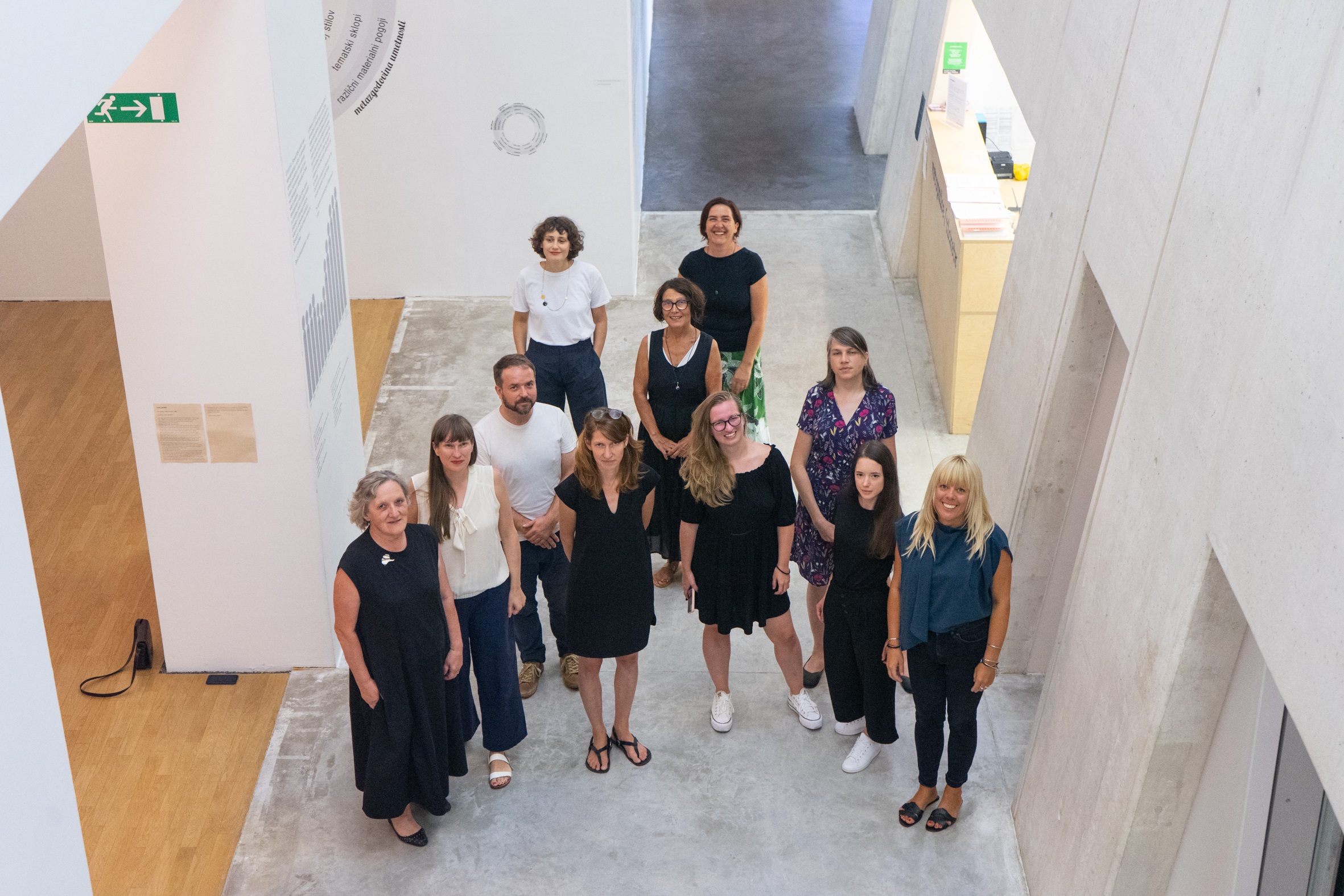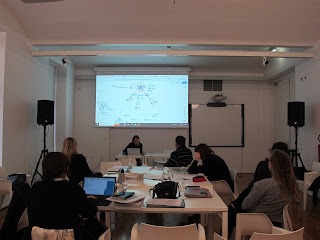Study Workshop at Moderna galerija, Ljubljana, 21-22 August 2023
On 21 and 22 August 2023, participants from the partner institutions of the ARTAS – Art Archives Study. Before and after 2004 project – the Archive of Fine Arts (Prague), basis wien (Vienna), and Moderna galerija (MG+MSUM, Ljubljana) – met for their second study workshop. The long-anticipated meeting took place at +MSUM, the Museum of Contemporary Art Metelkova in Ljubljana.
The two-year project ARTAS – Art Archives Study. Before and after 2004 (2023–2024) focuses on detecting changes in the way artists, curators, and institutions collaborated and connected under the new circumstances following the greatest enlargement of the European Union so far, which took place in 2004, especially in countries where the three participating archives are based. While based on statistical data analysis and standard research methods, the study also includes updating the data collections of the partner institutions and supplementing their material collections. Another goal of the project is exploring methods for future collaborations between European archives of contemporary art.
Group photo (from left to right): Jana Intihar Ferjan, Andrea Neidhöfer, Jan Kuntoš, Helene Baur, Barbora Špičáková, Adela Železnik, Veronika Rubášová, Sanja Kuveljić Bandić, Irena Lehkoživová, Ana Obid and Teja Merhar. Photo: Urša Rahne/Moderna galerija, Ljubljana
DAY 1
The Ljubljana workshop opened with a discussion about further approaches to and strategies for statistical data analysis. Having already collected structured metadata from their own databases and prepared lists of queries in the previous stages of the project, each archive evaluated the data for the first time at the workshop in Vienna. In Ljubljana, the participants continued with a summary, comparison and analysis of the results.
basis wien presented their conversion of a number of results from their database into percentages, which showed a significant increase in exhibitions held in Austria that include(d) people with some kind of geographical reference (born, living, or died in) to Czechia and Slovenia after 2004. As an example they also matched persons from the results for solo exhibitions with some kind of geographical reference to Austria in Slovenia and Czechia from the lists that the Archive of Fine Arts and Moderna galerija had prepared. An overlap of 57 matching people in both databases was extracted from the results. It was pointed out that in the comparison matching process it is easier to match people than exhibitions, as comparing the latter would present a problem due to the exhibition titles being in different languages.
The partners detected an important difference between the databases of basis wien and the Archive of Fine Arts (abART) on the one hand, and Moderna galerija’s RazUme database on the other: the list of published names provided by Moderna galerija included only artists, while the other two also included the names of curators, writers, politicians, and others. It was decided that this problem should be solved by matching with the results of Moderna galerija in such a way that only includes matches for artists.
The first common result for all three databases was thus detected, namely a large number of people without any geographical reference. This was clearly noticeable in the updated presentation of the results from the AbART database.
It became clear that the number of search results was overwhelming, making it difficult to draw any valid conclusions after comparing the results obtained from each archive's database – even though each partner offered interesting insights into their own data. It was agreed that each archive should continue the research autonomously, digging deeper into the actual results.
The program continued with the first workshop focus: the ARTEAST 2000+ COLLECTION, with an invited guest, the curator and writer Zdenka Badovinac, the Director of Moderna galerija in Ljubljana between 1993 and 2020, and until last month the Director of the Museum of Contemporary Art in Zagreb. The international Arteast 2000+ collection was initiated in the 1990s under the curatorship of Badovinac and her advisors Viktor Misiano, Piotr Piotrowski, Harald Szeemann, and Igor Zabel.
It is a collection of great importance, and is considered to be the first museum collection conceived with a focus on Eastern European postwar avant-garde art put in a broader international context. The Arteast 2000+ collection is housed in the Museum of Contemporary Art Metelkova in Ljubljana (+MSUM).
Badovinac talked about her decision to start the collection, the partners, the Ministry of Culture of the Republic of Slovenia, her advisors, the Museum of Contemporary Art Metelkova, and also about Manifesta 3, which opened at the time of the first presentation of the Arteast 2000+ collection in Ljubljana. She also talked about her colleague Igor Zabel and his work in Moderna galerija.
The talk took the form of an interview and was recorded. Its transcription will soon be available on this blog. During the talk some archival materials from the Moderna galerija Archives Department relating to Arteast 2000+ were circulated. All the participants also had the opportunity to get the catalogues of Moderna galerija exhibitions as part of publications exchange.
The conversation with Badovinac was followed by a guided tour of the current installation of Arteast 2000+ in +MSUM, Things Break Down. A selection of works from Moderna galerija’s Arteast 2000+ and national collections, by Adela Železnik, the Public Programs Curator at MG+MSUM.
The workshop continued with the second item on the program: MANIFESTA 3, the European Biennial of Contemporary Art, which took place in Ljubljana between 23 June and 24 September 2000. The workshop participants welcomed Urška Jurman, a curator and writer, and currently the Program Director of the Igor Zabel Association for Culture and Theory.
Jurman was the coordinator of the research project Manifesta in Our Backyard (2000), which was not officially connected with the Manifesta 3 biennial, but was an independent project of the SCCA Ljubljana, focusing on the reception of the event by the cultural institutions in this city.
Jurman talked about the structure of the project, its analysis, and the results published in the platforma SCCA magazine, also available online on the project’s official website.
Next, Jurman presented the curator, writer, and critic Igor Zabel (1958–2005). Zabel worked as a curator for Moderna galerija in Ljubljana (1986–2005), serving, among others, as a coordinator of Manifesta 3 (2000) and on the International Board of Manifesta.
Again, magazines and archival materials on Manifesta 3 from the Moderna galerija Archives Department were circulated, and an excerpt from the documentary The Curator’s Room — Igor Zabel: How to Make Art Visible? was shown, and the presentation was recorded.
At the end of the first day, the participants visited the Moderna galerija Archives Department to see part of the Igor Zabel Archive.
DAY 2
The first focal point on the second day of the meeting was the ESSL COLLECTION and the ESSL ART AWARD CEE, which had already been discussed at the workshop in Vienna. In Ljubljana, the participants had a chance to talk to Igor Španjol, a curator and writer who works in the Collections and Exhibitions Department of MG+MSUM.
Španjol was a jury member of the Essl Art Award for Central and South-Eastern Europe (2009–2015) and a coordinator of the Essl Art Nominees Exhibitions in Slovenia (2009–2015). He shared his experiences of being part of the Essl Art Award CEE activities. The talk with Španjol was also recorded, and accompanied with a variety of archival materials from the Moderna galerija Archives on the Essl Award.
The second day of the workshop continued with an interview with Jana Intihar Ferjan, a curator at the Moderna galerija Archives Department.
While the main focus of the interview was the international connections of contemporary art archives, Intihar Ferjan also briefly presented the history of the Moderna galerija Archives Department and its database RazUme. Intihar Ferjan has had an important role in shaping Moderna galerija’s archives, and took part in the EU research project Vector (2000–2003), which formed the basis of today’s platform European-art.net, which also unites the three partners of the ARTAS project. She brought some publications and early correspondence for the participants to peruse. The interview was recorded and will be transcribed.
Next followed the presentation of the project Digitizing Ideas: Archives of Conceptual and Neo-Avantgarde Art Practices by Ana Mizerit, a curator in the Exhibitions Department of MG+MSUM. As part of a joint project of the Museum of Contemporary Art Zagreb, the Museum of Contemporary Visual Arts from Vojvodina, the Museum of Modern Art in Warsaw, and Moderna galerija in Ljubljana, the latter digitized and catalogued 477 items of archival materials of the OHO group, a Slovenian conceptual neo-avant-garde art collective active between 1966 and 1971. The participants were also able to see selected original archival documents that Mizerit had prepared.
The program continued with a guided tour of the exhibition What Do Crocodiles Dream About? by Bojana Piškur, a curator in the Collections and Exhibitions Department of MG+MSUM. Envisioned by Bojana Piškur, Daniela Berger, Riksa Afiaty, and Shada Safadi, the exhibition brings together voices, cosmologies, ecologies, and human and more-than-human beings from diverse parts of the world: Gaza, Jerusalem, Jisr al-Zarqa, Ljubljana, Majdal Shams, Puchuncaví, Ramallah, Santiago, West Papua and elsewhere.
The workshop ended with the formal conclusion of the meeting and a look to the future, with the participants sharing ideas and guidelines for the next stages of the project. It can be concluded that the workshop was successful and that participants shared many interesting ideas that can be used in the further stages of the project.
The afternoon program consisted of gallery visits. The participants visited, among others, the temporary exhibition at the Museum of Modern Art (MG+) in Ljubljana (Don’t Dream Dreams. A selection from the Art Collection Telekom and Two Commissioned Works), where they were also able to choose some publications at the MG Bookstore to be delivered to their libraries as part of publications exchange.















Comments
Post a Comment